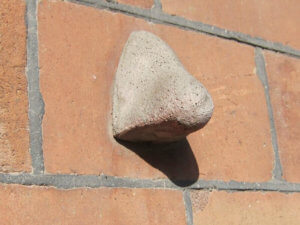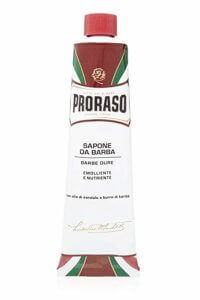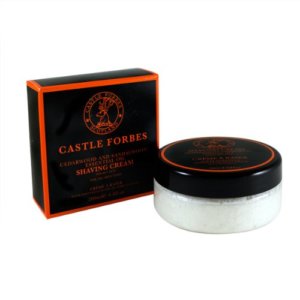
[Updated March, 2022] Sharpologist has previously looked at what Menthol and Bay Rum are and why they are popular in shaving products. This time let’s look at Sandalwood. What is it? Where does it come from? Why is it popular in shaving products?
Sandalwood Is Not A Single “Thing”
Sandalwood is not a single scent or even a single plant. Per Wikipedia:
“Sandalwood is a class of woods from [slow-growing] trees in the genus Santalum. The woods are heavy, yellow, and fine-grained, and unlike many other aromatic woods, they retain their fragrance for decades.
“Sandalwoods are medium-sized hemiparasitic trees, and part of the same botanical family as European mistletoe. Notable members of this group are Indian sandalwood (Santalum album) and Australian sandalwood (Santalum spicatum); others in the genus also have fragrant wood. These are found in India, Nepal, Bangladesh, Pakistan, Sri Lanka, Australia, Indonesia, Hawaii, and other Pacific Islands.
“Sandalwood oil is extracted from the woods for use…. Both the wood and the oil produce a distinctive fragrance that has been highly valued for centuries. Consequently, species of these slow-growing trees have suffered overharvesting in the past century.”
The genus Santalum has more than 19 species. In Western Australia, Indian sandalwood (Santalum spicatum) is grown on a large scale. This species is now the primary source of sandalwood used in commercial oil production.
Why Is Sandalwood So Expensive?
However, what most people think of as “genuine” Sandalwood is Santalum album, a threatened species indigenous mainly in southern India. Although most genuine Sandalwood trees have a government-controlled harvest due to over-harvesting for years, many trees are illegally cut down for their oil.
Traders often accept oil from closely related species, as well as from unrelated plants with similarly-scented wood or oil, including (in alphabetical order):
- Adenanthera pavonina
- Baphia nitida
- Eremophila mitchellii
- Myoporum platycarpum
- Myoporum sandwicense
- Osyris lanceolata
- Osyris tenuifolia
West Indian Sandalwood, Amyris balsamifera, is a completely different plant from any of the others mentioned here.
However, most woods from these alternative sources lose their aroma much more quickly than genuine Sandalwood.
Genuine Sandalwood is very expensive compared to other types of woods, and to maximize profit it is harvested by using the entire tree instead of sawing it down at the trunk close to ground level. That way the wood from the stump and the root, which have high levels of sandalwood oil, can be used.
What Does Sandalwood Smell Like? The Sandalwood Fragrance (More Or Less…)

[Note: Amazon links are affiliate.]
“Sandalwood oil has a distinctive soft, warm, smooth, creamy, and milky precious-wood scent. It imparts a long-lasting, woody base to perfumes […] as well as a fixative to floral and citrus fragrances. When used in smaller proportions in a perfume, it acts as a fixative, enhancing the longevity of other, more volatile, materials in the composite.”
Since the wood (and, therefore, oil) is so rare and expensive, cosmetic companies are now trying to find synthetic substitutes to imitate the scent of sandalwood. As Craig K mentioned in Should Scent Reformulation Be Reformed?, “Sandalwood and, famously, oud are also ingredients that manufacturers talk up a lot when advertising a new fragrance but which are widely simulated rather than used in their authentic natural forms (which are much more costly.)”
Isobornyl cyclohexanol is one of the most common synthetic fragrance chemicals produced as an alternative to natural Sandalwood, but there are dozens of materials that can be used, and many luxury fragrances use complex accords that might consist of thirty or forty such compounds.
As for variations, I have previously mentioned that Sandalwood’s scent is masculine and “can vary from an earthy dampness to piney to a kind of spice.” This is no doubt due to the number of variations previously described here, both natural and artificial.
And the prices for product are just as variable. You can spend a little by getting something like Proraso Sandalwood or spend a lot more on something like Castle Forbes Sandalwood & Cedar.
How Is Sandalwood Oil Used?
Sandalwood oil’s main components are used in aromatherapy and to prepare soaps.
As Larry Isaacs (MD) mentioned in Are Wet Shavers Also Aromatherapy Patients? –
“Sandalwood … oil is composed of 90% sesquiterpene alcohols and 50% of those are Beta Santalol. Used in Ayurvedic medicines for many illnesses, Smelling the oil increases pulse rate, systolic blood pressure, and skin conductivity. In the lab sandalwood interferes with tumor formation. Beta Santalol (and its synthetic analogue Sandalore) both bind to olfactory receptors in skin to promote healing.”
That said, there are few scientific studies that objectively demonstrate benefits. There have been a lot of claims that say Sandalwood oil is believed to be beneficial in treating including anxiety, bronchitis, diarrhea, fatigue, fever, gallbladder problems, high blood pressure, indigestion, insomnia, liver problems, low libido, sore throat, and urinary tract infections.
The benefits that are getting traction in the research community include those for treating anxiety, insomnia, and mental alertness.
There are no known side-effects of Sandalwood oil, though there is always the chance that it might cause minor skin irritation in some people.
Sandalwood In Shaving Products
(I’m limiting this article to shaving creams and soaps. Adding balms, splashes, colognes, etc. to the topic will complicate things further and probably best left to a follow-up article if there is enough interest.)
A problem with determining which variety of “Sandalwood” a shaving product may have is the ingredient reporting requirement of whatever country it’s being manufactured in. As mentioned in “Is Your Shaving Cream Trying To Kill You? An Ingredient Teardown“:
“The “Parfum” entry in the ingredient list is itself made up of a number of additional ingredients. And to complicate matters, the listing and usage of…ingredients is largely dependent on the country of manufacture. As TOBS Sandalwood is made in Europe the labeling holds to European Union standards. If it was produced in the US this section could simply be labeled as “parfum” or “fragrance” with no additional notations.”
In other words, the disclosure of individual ingredients like essential oils is optional. EU regulations on ingredient disclosure do go further with a required disclosure of chemicals that are known allergens which are required to be included on the product label if they exist in the finished product over a certain percentage, but this is entirely separate from whether or not someone puts the actual “sandalwood essential oil” in the ingredient listing or just lumps it in the “parfum” term.
To complicate matters even further, some “Sandalwood” products that bury an ingredient in “fragrance” or “parfum” may not really consist of realistic sandalwood compounds, but instead use “fantasy” ingredients, of which sandalwood may be a part, but is in no way the only major constituent. Such fragrances are often not recognizable as having any resemblance to natural sandalwood, so it may be best to proceed with caution when sampling these products.
So the type and strength of “Sandalwood” all play a part. It could very well be that a product may have a tiny bit of “real” Sandalwood oil and a lot more of a synthetic Sandalwood scent.
When in doubt, or if you’re curious, the best solution is to contact the manufacturer and ask.
That said, some shave creams and soaps do explicitly list the version of that is used in their “Sandalwood” product. Here is a random selection:
Santalum album shave products: Casswell-Massey (as “Santal Album”), Castle Forbes, Cremo (brushless version), Cyril Salter, Muhle, Proraso.
Santalum spicatum shave products: Rocky Mountain Barber, Ursa Major.
“Fragrance” shave products: DR Harris, Geo. Trumper (it’s worth noting that Trumper specifically listed Santalum spicatum in older formulation listings), The Art Of Shaving (see also Sharpologist’s review), Taylor Of Old Bond St. (consistently near the top of Amazon’s best selling shaving creams list. See also Sharpologist’s review), Truefitt & Hill, and many others….
And again remember that genuine Indian Sandalwood (Santalum album) is very expensive so even if the ingredient list has it, the actual quantity might be very small indeed.
Sharpologist Reviews Of Sandalwood Shave Products
Truefitt And Hill Sandalwood Shaving Cream Review
Lather And Wood Shaving Co. Sandalwood Shaving Soap
Taylor Of Old Bond Street Sandalwood Shave Cream Review
The Art of Shaving Sandalwood Shaving Cream: Deal Or Dud?
Summing Up
So there you have the wonderful–albeit slightly confusing–world of Sandalwood in men’s shaving products.
What do you think of Sandalwood? Have a favorite product? Does the scent relax or invigorate you? Leave a comment below.
Thanks to Will from Barrister and Mann, and Frances and Douglas from Phoenix Artisan Accoutrements, for their help with the preparation of this article.



Excellent read I have found the variation of Sandalwood scents a bit mysterious and this article sheds some light on why that is. TOBS Sandalwood is my preference and definitely falls into the mild / warm scale of scents for myself. Others in my collection are Cremo and Art of Shaving the AOS has a very strong scent. Wonder if a Sandalwood tree would live in the Northeastern USA?
Thank you, Mark, for lighting what has always been a dark path for me.
“Why 4 of my sandalwood scents all have a different odour.
And that is minor compared to a hunt for my favourite scent, Lilac. Six and all different. None are close to those white, mauve and purple flowers in my childhood back yard. Although 2 are approaching my memory.
And all attempts at evergreen odours I find quite putrid.
I do believe that a big part of my problem may very well be my having smoked for 29 years though.
Which are the two “close” Lilac products?
I use pure Santalum Album oil as a fragrance (instead of a cologne) and have done so since 1968. Keihls used to have the oil but stopped when they were bought by Lorieal (sp.?). I but up their supply when the stopped selling it but have finally found someone who sends me the pure oil from India. Yes, it is very expensive and near impossible to find, here, as export from India is illegal (due to endangerment). I find it soothing and comforting but am not sure of it’s other effects. Australian Sandalwood does not smell at all the same and is much weaker in fragrance.
This was a good and informative article. I am fairly particular about Sandalwood. I enjoy a deep scent such as Castle Forbes and Midnight & Two’s Study, but do not like sweeter Sandalwood scents.
Thanks for another great and informative article. I happen to have the Proraso Sandalwood and I think its great.
I love sandalwood and just learned a lot about it. Thank you. To add to your list, I checked and the Proraso Sandalwood lists Santalum Album as their sandalwood.
As always, very good article and research! Keep them coming Mark..always a pleasure to read your articles!
Thank you…
Great article. Very informative.
Comments are closed.